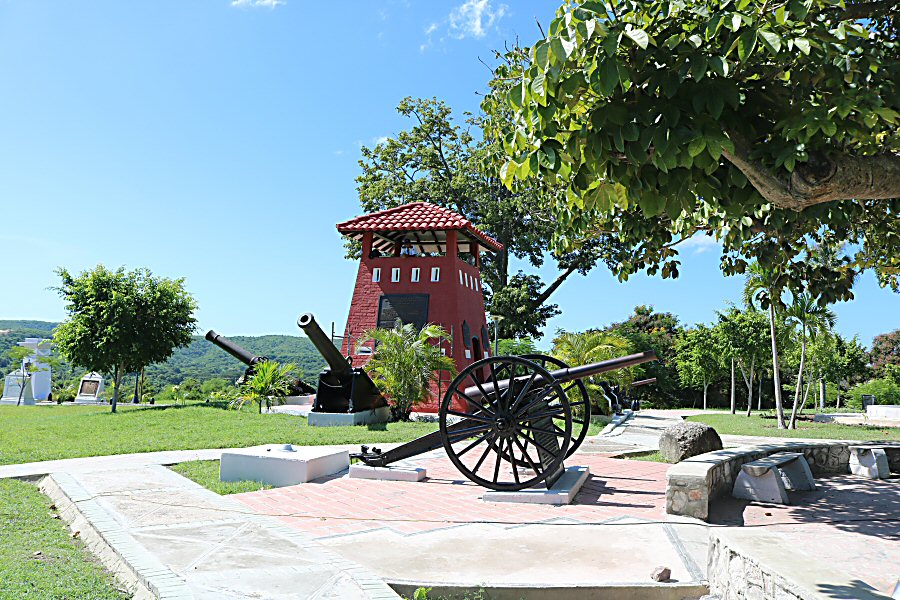
A pill box is a small fort used as an post. It was created to remind us of the fortress built to protect San Juan Hill when the war began, but it is an artistic creation that has nothing to do with the original.
It has a wooden roof covered with reddish tiles. On three sides of the building, there are large bronze plaques with the names of soldiers belonging to the Spanish Army's 1st Cavalry Brigade and the 1st, 2nd, and 3rd Infantry Brigades who died or were injured in the battles.
You can reach the upper part of the building via a narrow spiral staircase. Here are several plaques showing the location of the military forces in the San Juan area. Two plaques, one in English and the other in Spanish, were placed at the main entrance of the building, referencing the actions of Colonel José González Valdés, in 1928.
THE OBELISK

It is a long, narrow structure made of concrete, shaped like a truncated pyramid. It is crowned by a cannonball. On the plaque hanging on one side of the obelisk, it is read that this monument was erected “in memory of the officers and men of the US' Army who were killed in the assault and capture of this ridge and the siege of Santiago de Cuba in 1898".
UNKNOWN AMERICAN SOLDIER
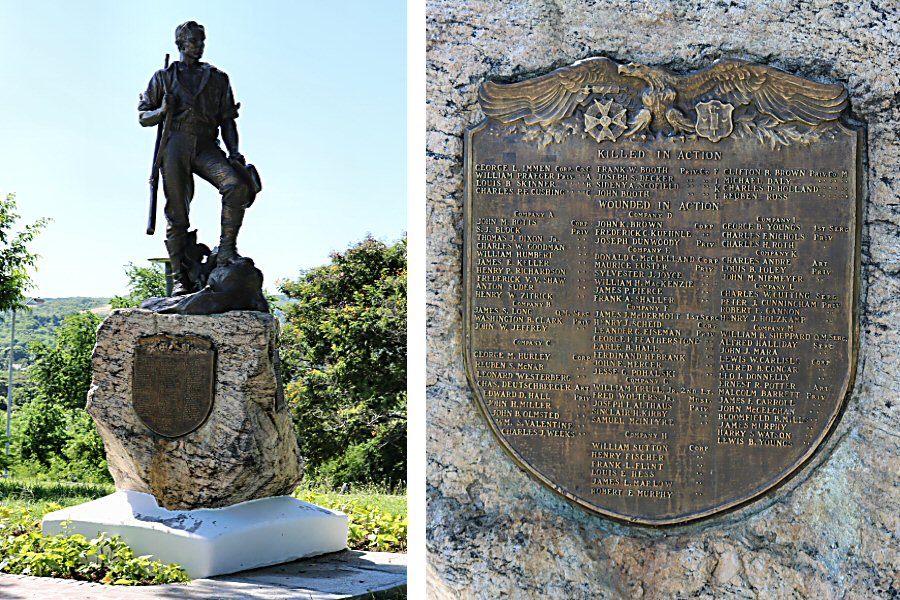
In 1924, Louis Culliver, a Spanish-American War veteran and New York state senator, made a proposal to erect a monument in the San Juan area. This monument would be a monument with the name Unnamed American Soldier, depicting a soldier from the 71st Regiment of New York Volunteers. Accordingly, the states participating in the war would bear the cost of 10.000 dollars.
At the end of the same year, a commission was established under the chairmanship of Captain Walter Joyce, who visited Cuba to determine the location of the monument to be erected. The monument was designed by Joseph Pollia, an artist of Italian origin, who was living in the United States.
In 1926, the work was unveiled at a ceremony attended by Colonel José González Valdés, Chief of the Oriente Military District, and several speakers.
HISTORICAL CANNONS

The hontario (a cannon fixed in place) that belonged to the Spanish cruiser Reine Mercedes that had been stationed in the battery of Punta Gorda (a small peninsula within the bay that is an ideal place to control the mouth of the bay), and the palm trees that Colonel González Valdés himself planted in the historical park.
UKNOWN MAMBÍ
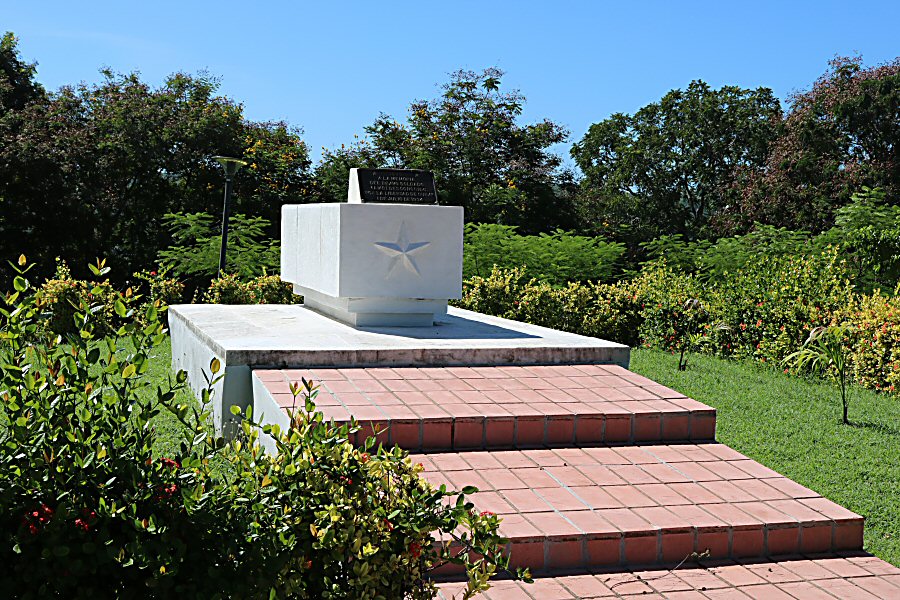
In 1928, José González Valdés supervised the exhumation of a body buried on the Quintero family farm in San Juan de Chulí, then El Caney municipality. Valdés' intention was to erect a monument in memory of the hundreds of Cuban soldiers who fought against the Spaniards in these lands and were buried there where they had died. It was certified by a notary that the body belonged to a 25-year-old Cuban soldier. The remains were deposited in the Moncada Barracks in an urn, awaiting the decision of the site where the commemorative construction would be erected.
In 1934, the ashes were deposited in the burial mound of a monument consisting of a stepped base, a prismatic body with a star in high relief in front of it. On the plaque on the body the unnamed heroes (mambis) who fought for the independence of the country were commemorated.
TREE OF PEACE
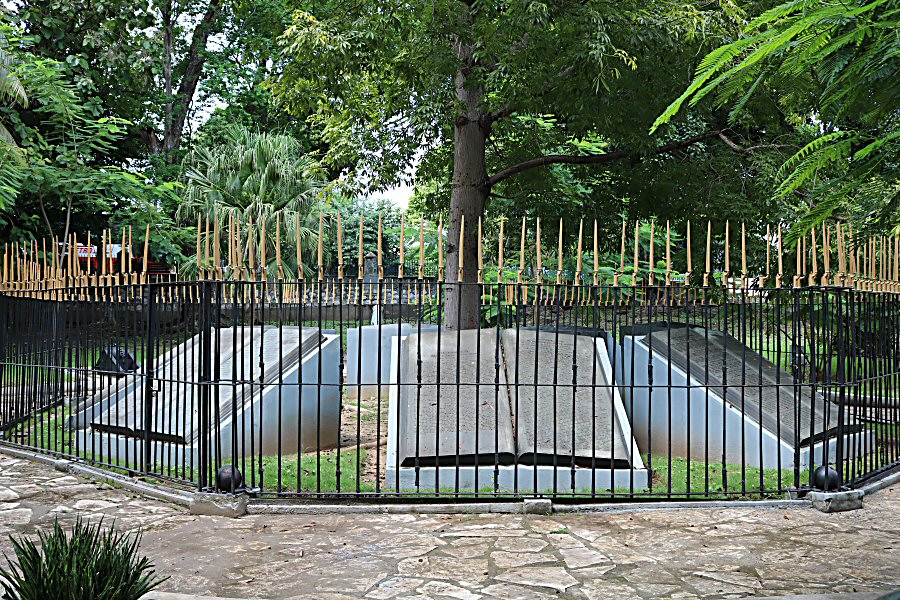
The surrender meeting of Santiago de Cuba was held under a ceiba tree in an area very close to San Juan Hill. It was decided to build a monumental complex here as part of the commemoration of the 100th anniversary of the historical event. However, only the trunk of that ceiba, called Tree of Peace, remained.
According to the project, the tree was surrounded by a fence and cannons were placed around it. The names of the Liberation Army members who died in the war were written on the stone blocks.
This place is on the right, right at the beginning of the road leading to the monumental area on San Juan Hill.

Colonel José González Valdés, Chief of the Oriente Military District, who took office in 1926, wanted to erect a monument in memory of Victorious Mambí. He allocated a budget of $12,000 for this. American sculptor Joseph Polia was chosen for the construction of the monument.
The Mambí statue stands on a pink marble pedestal, placed on a three-stepped base. There are war-related reliefs on both sides of the pedestal. While the capture of the San Juan Fortress on the right is depicted, the place on the left is empty, probably because it is under restoration. Reliefs are the work of Santiago-based sculptor Rodolfo Hernández Giró.
On the front of the pedestal, there are the national coat arms and a plaque: “A la gloria del mambí victorioso (To the Glory of the Victorious Mambí) – 1929”.
On the pedestal, there is the bronze statue of Mambí, holding a rifle.
The left wing of the hill where the monument is located, is in a more special position, because you have to see and pass other monuments to reach this secluded area.
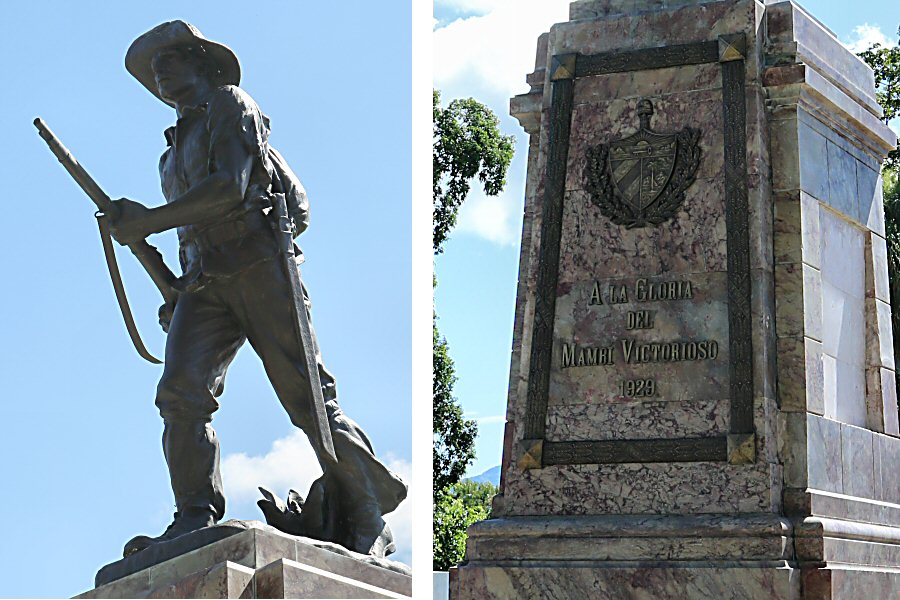
MONUMENT TO THE SPANISH SOLDIER
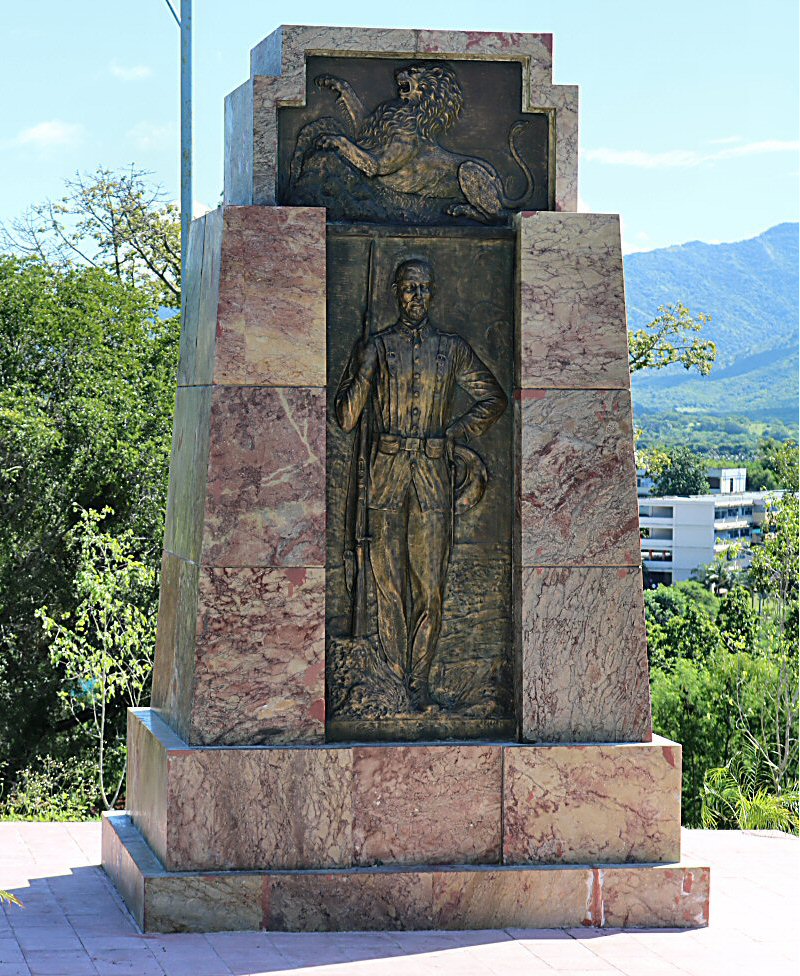 While
the foundation was being excavated on San Juan Hill for the
statue of Victorious Mambí in 1927, skeletal parts of Spanish
soldiers who lost their lives in the war in 1898, were found and
these were buried with a solemn ceremony in the mausoleum
prepared in Santa Ifigenia Cemetery.
While
the foundation was being excavated on San Juan Hill for the
statue of Victorious Mambí in 1927, skeletal parts of Spanish
soldiers who lost their lives in the war in 1898, were found and
these were buried with a solemn ceremony in the mausoleum
prepared in Santa Ifigenia Cemetery.
In a letter to the Spanish consul, published in the newspaper,
Colonel José González Valdés addressed the Spaniards living in
Santiago de Cuba and called for the erection of a monument in
memory of their citizens who fought heroically and died during
the war. Valdés' aim was to bring together the monuments to
commemorate the soldiers of the three states that took part in
the war. Valdés' effort was not limited by publishing a letter
only, but also succeeded in the acceptance of his project by the
Cuban President Gerardo Machado.
Like the obelisk, this monument is a pyramid-shaped block. It is covered with the pink marble used in the monument of Victorios Mambí. There are two bronze reliefs on the front of the monument. While the upper one depicts a lion, which was important for the Spanish, the lower one depicts a Spanish soldier on guard. There are two reliefs more behind the monument. The upper one shows the coat of arms of Spain and Cuba, and the lower one shows an inscription that indicates the crucial moments of the Spanish presence on the island.
BUST OF COLONEL JOSÉ GONZÁLEZ VALDÉS
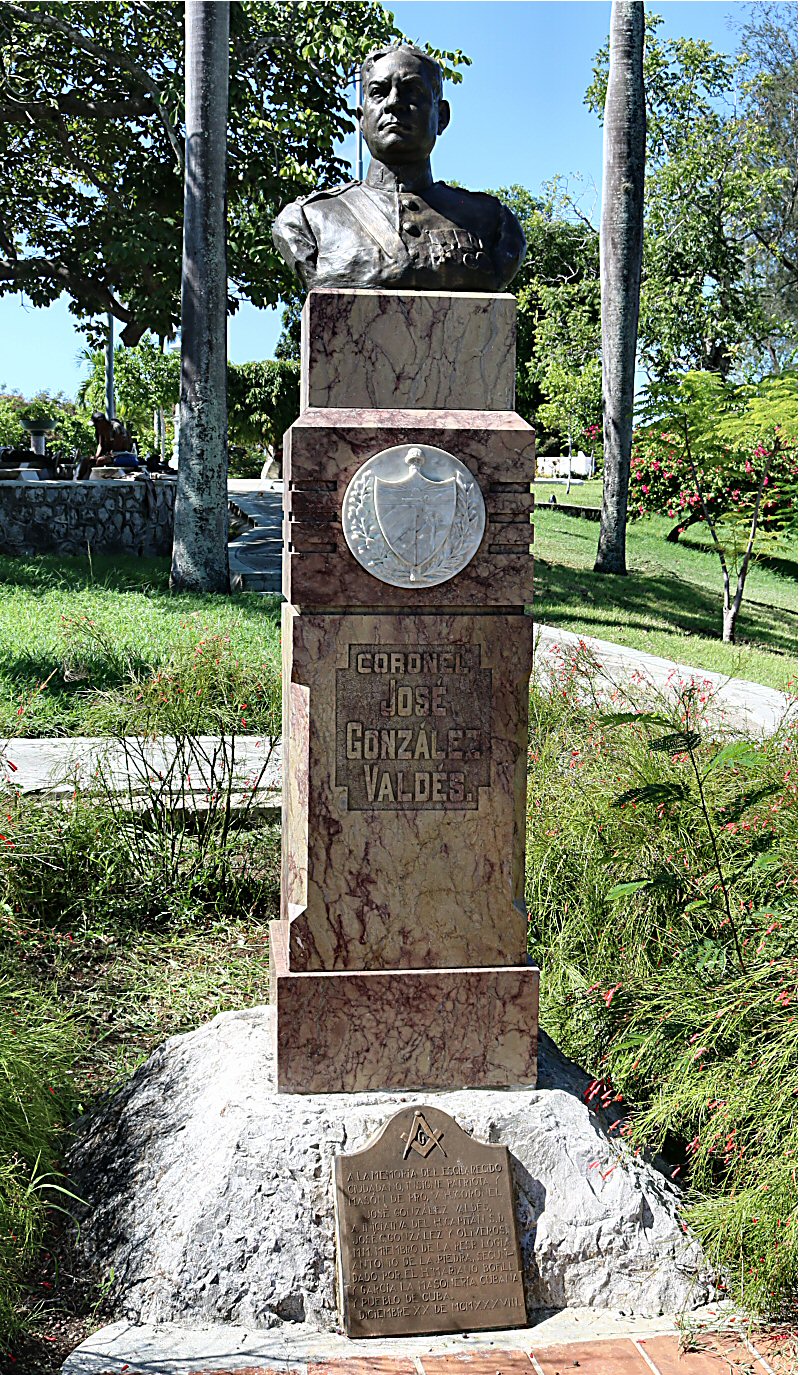 Colonel
González Valdés, who worked as the head of the Oriente Military
District for four years, made a lot of effort for the
conservation of the historical sites of the former province of
Oriente. Especially his outstanding contribution to the
construction of Parque Histórico de San Juan cannot be
forgotten. Therefore, Santiago City Council agreed to declare
José González Valdés Adoptive Son of the city on August 9, 1928.
Colonel
González Valdés, who worked as the head of the Oriente Military
District for four years, made a lot of effort for the
conservation of the historical sites of the former province of
Oriente. Especially his outstanding contribution to the
construction of Parque Histórico de San Juan cannot be
forgotten. Therefore, Santiago City Council agreed to declare
José González Valdés Adoptive Son of the city on August 9, 1928.After the death of José González Valdés in Havana in 1931, Captain José González Oliveros, who served as his assistant at the First Military District of Oriente, began efforts to build a monument to commemorate this patriot.
The bust was commissioned by the Masonic Association and delivered to Oliveros' brother. In 1940 the bust was unveiled between four palm trees that Colonel González Valdés himself planted in the historical park.
The bronze bust is the work of sculptor Lozada. It was cast in the workshops of Mariano Bofill in Manzanillo, while the pink marble pedestal was made in the Prieto Marble Factory in Santiago de Cuba.
SPANISH-CUBAN-AMERICAN WAR RELIEF
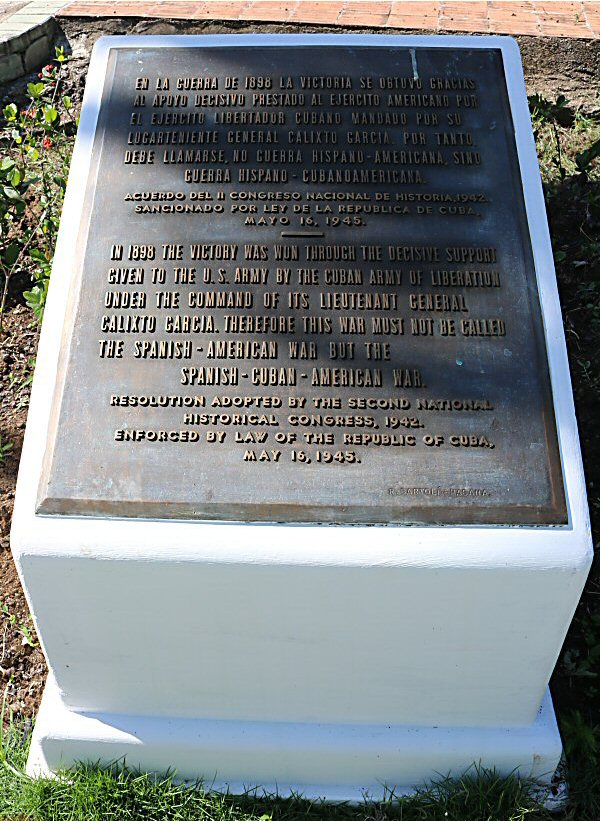 During
the 2nd National History Congresses in the 1940s, intellectual,
architect and engineer Ulises Cruz Bustillo from Santiago de
Cuba used the term Spanish-Cuban-American War to better reflect
the decisive role of the Liberation Army, which fought alongside
US soldiers for the independence of their homeland, and he
suggested using this term instead of the term Spanish-American
War. The proposal was accepted at the congress and later it
became law in 1945.
During
the 2nd National History Congresses in the 1940s, intellectual,
architect and engineer Ulises Cruz Bustillo from Santiago de
Cuba used the term Spanish-Cuban-American War to better reflect
the decisive role of the Liberation Army, which fought alongside
US soldiers for the independence of their homeland, and he
suggested using this term instead of the term Spanish-American
War. The proposal was accepted at the congress and later it
became law in 1945.In 1946 a relief was unveiled at a ceremony held with the participation of many historians including Dr. Emilio Roig de Leuchsenring. This term change is reported in English and Spanish in the text on the relief.
THE LAST MONUMENT
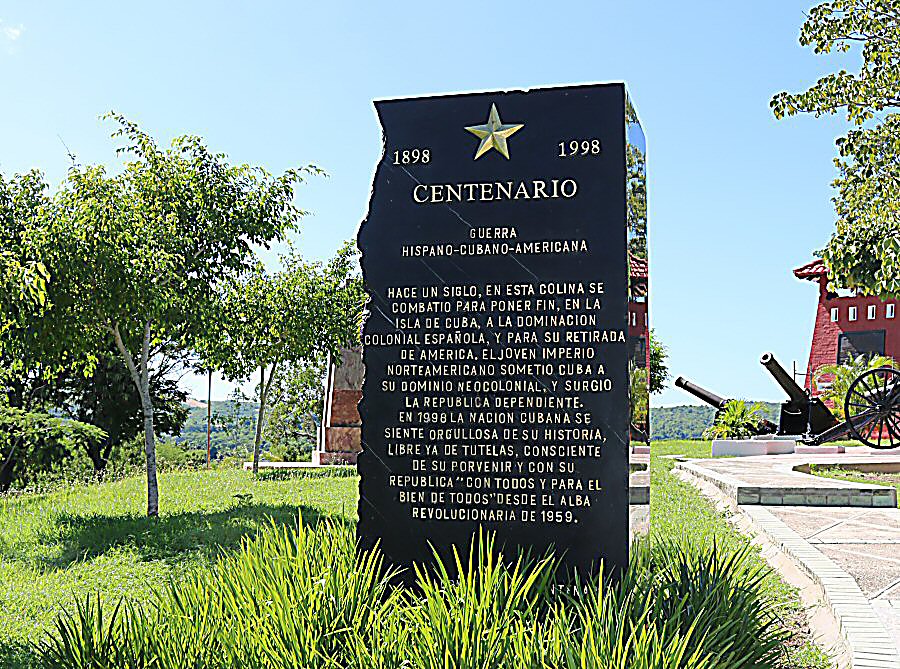
On the centenary of the city's surrender on June 17, 1998, the last monument in this historical area was unveiled. It was a black marble monolith approximately three meters high. A text was written on it in gold letters: "A century ago, this hill was fought to put an end to Spanish colonial domination of the island of Cuba and its withdrawal from the Americas. The young U.S. empire subjected Cuba to its neocolonial domination, the dependent Republic emerged. In 1998, the Cuban nation is proud of its history free of tutelage, aware of its future and with its Republic "With all and for the good of all" since the revolutionary dawn of 1959."